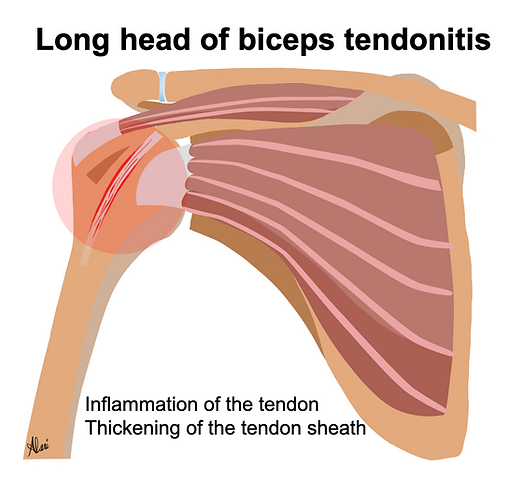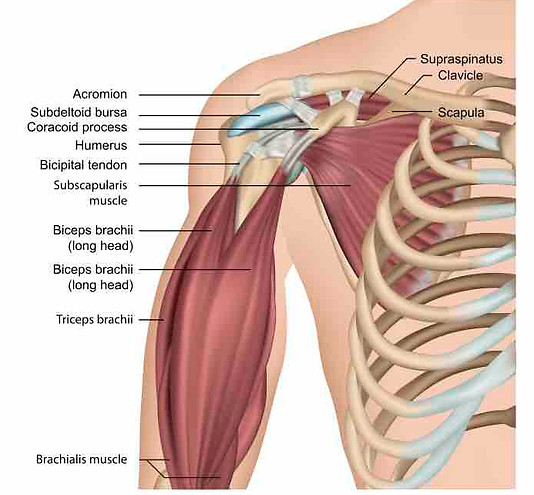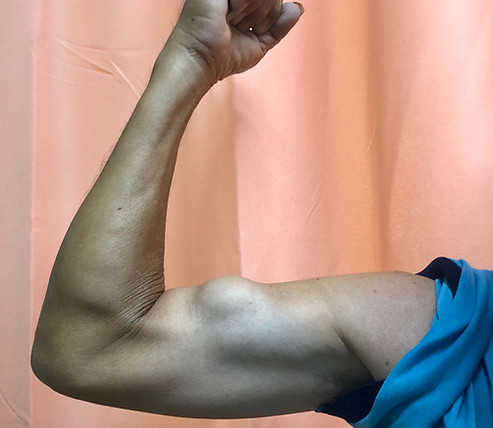top of page
Ultrasound guided long head of biceps injections
Biceps tendonitis; biceps tenosynovitis

What is biceps tendonitis?
What is biceps tendonitis?
Biceps tendinitis refers to inflammation of the biceps tendon. The tendon runs at the front of the shoulder/upper arm, and inflammation typically results in pain at the front of the shoulder. It is more common in people who do weight lifting and overhead sports activities like tennis.
The biceps is the large muscle at the front of the arm. It has two tendons at the shoulder level, the short and long head tendons and most problems arise from the long head of the muscle. Short-head biceps problems are rare and will not be discussed in this article.
The long head of biceps tendon runs in a special groove “called the bicipital groove” within the upper humerus (the arm bone) at the front of the shoulder. If the tendon moves outside this groove, the condition is referred to as long-head biceps tendon subluxation or dislocation. The tendon is covered by a thin layer called the tendon sheath.
Problems with the lower tendon of the biceps are a different subject, and this can cause pain at the level of the elbow joint and discussed in a different article.


What are the clinical features of long head of biceps pain?
The main symptom is pain at the front of the shoulder and the upper arm (sometimes, the pain is felt outside the shoulder). Shoulder movements above the head level bring on the pain cab. In weight lifting, the specific exercises that can exacerbate the pain include bench press, overhead press and biceps curls. The pain is felt at the front of the shoulder and not in the elbow. Biceps elbow pain is due to problems with different parts of the muscle (called the distal biceps tendon) and is discussed in a different article.
What are the causes of long head biceps tendon pain?
There are various causes for long-head biceps tendon shoulder pain; these include:
-
Injury from putting extra stress upon the tendon (for example, due to heavy weight lifting at the gym)
-
Fall/direct injury to the tendon
-
Sometimes there is no obvious cause.
What other shoulder conditions can cause similar symptoms for biceps tendonitis?
Other shoulder conditions that can be mistaken for biceps tendonitis include:
Biceps tendonitis vs. rotator cuff problems
Biceps tendonitis pain is located at the front of the shoulder. Rotator cuff pain is usually more diffuse but can also be felt at the front of the shoulder and upper arm. Weakness is a feature of rotator cuff problems. A shoulder ultrasound would be useful to differentiate the two conditions.

What is the spectrum of long head biceps tendon disease?
There are a few conditions that can affect the long head of biceps tendon:
- Long head biceps tendon subluxation/dislocation. The long head of biceps tendon normally runs in a special groove within the bone at the front of the shoulder. Subluxation or dislocation happens when the tendon moves outside the groove. This usually happens if there is an injury to the ligaments responsible for keeping the long head of biceps tendon in its position. Also, sometimes injury to the subscapularis tendon (one of the rotator cuff tendons) can result in this.
- Long head of biceps tenosynovitis. This refers to inflammation of the layer covering the tendon resulting in excess fluid surrounding the tendon.
- Tendonitis. This refers to inflammation of the long head of biceps tendon itself, resulting in tendon thickening.
- Long head of biceps tendon injury/tear. This can involve part of the tendon (partial tear) or the whole thickness tear of the tendon (referred to as full-thickness tear or tendon rupture). The incidence of the latter increases after the age of 50. A long head of biceps rupture may result in bruising and a focal bulge of the biceps muscle when you flex your arm (referred to as “the Popeye Sign” and seen in the photo).

How to diagnose long head of biceps problems?
When there is suspicion of long head of biceps injury, your doctor will refer you for a shoulder ultrasound scan. This is an excellent method to assess for long head of biceps problems.
What is the treatment for long head of biceps tendon pain?
The treatment of biceps tendonitis usually starts with physiotherapy to strengthen the biceps muscle and the rotator cuff and shoulder girdle muscles. Anti-inflammatory tablets and avoiding certain exercises are also useful for management.
Imaging is very useful to look for any cause of biceps tendon irritation or impingement. Shoulder ultrasound and MRI examination are very useful for the assessment.
In cases of long head of biceps rupture, surgical treatment is not routinely indicated as the other component (the short head of biceps) usually compensates. Therefore, long head of bicep tendon ruptures is usually managed conservatively with physiotherapy.

Does ultrasound-guided steroid injection help with biceps tendonitis?
If the pain from long head of biceps tendon problem is not responding to conservative management, then an ultrasound-guided corticosteroid injection might be considered.
Corticosteroid (cortisone) is a potent anti-inflammatory medicine routinely used to manage inflammatory conditions (like bursitis, arthritis and tendinosis). A cortisone injection will reduce the inflammation around the long head of biceps tendon, and it is appropriate for managing tendinosis/tendinopathy, tenosynovitis (inflammation of the tendon sheath) and sometimes partial tear of the tendon. The cortisone injection aim is to help you manage the condition, usually by undergoing a physiotherapy program and strengthening the biceps and the rotator cuff muscles.
The most commonly used type of steroid injection for subacromial bursa injection is methylprednisolone (Depo-medrone). This is a long-acting preparation that takes a few days to start working. Current evidence suggests that cortisone can improve pain and function for up to 3 months, but in some cases, it can last longer. The injections usually also contain a local anaesthetic that provides immediate pain relief lasting a few hours.
Performing these injections under ultrasound guidance is very useful as it allows for live visualisation of the needle to ensure accurate placement into the inflamed tendon sheath at the site of inflammation. Ultrasound guidance results in more accurate, less painful and faster procedures, with better outcomes than these injections without guidance. Some evidence showed that ultrasound-guided injections in cases of biceps tendonitis resulted in a significant reduction of pain in approx. 80% of the cases.
The biceps tendon can also be involved in shoulder impingement syndrome, and therefore it makes sense to perform a targeted ultrasound-guided steroid injection into the long head of biceps tendon sheath if an ultrasound-guided sub-acromial bursa injection did not result in sufficient pain relief. The long head of biceps tendon is closely related to the rotator cuff tendons and therefore referred to as the 5th rotator cuff tendon and often involved in rotator cuff type shoulder pain.
Recent posts
Related posts
Categories
What are the clinical features of long head of biceps pain?
What are the causes of long head biceps tendon pain?
Mimics of biceps tendonitis
Biceps tendonitis vs. rotator cuff problems
What is the spectrum of long head biceps tendon disease?
How to diagnose long head of biceps problems?
What is the treatment for long head of biceps tendon pain?
Does steroid injection help with biceps tendonitis?
Shoulder conditions and treatments

Specialist Consultant Musculoskeletal Radiologist Doctor with extensive experience in image-guided intervention
To book a consultation
Call us on 020 8050 9885 or Book online
The Musculoskeletal Ultrasound & Injections clinic
Brentford, TW8 9DR

bottom of page






















